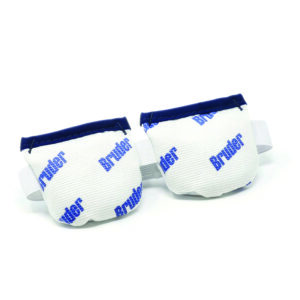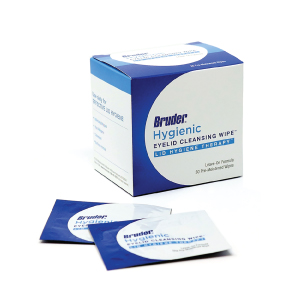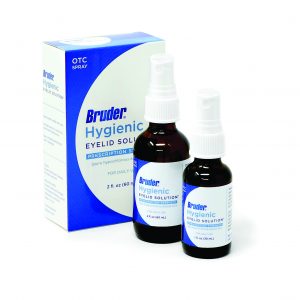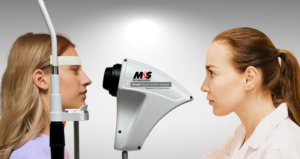How do your eyes feel after a long day spent in front of the screen? Over half of Americans report looking at a computer most of the day, every day and nearly 2 out of every 3 American adults experience some degree of eye discomfort on a daily basis. The good news is that there are several steps you can take to save your eyes from this condition (called digital eye strain or computer vision syndrome). Adding some self-care for your eyes to your daily hygiene routine is easy, and your eyes will thank you.
What is Digital Eye Strain?
According to the American Optometric Association, digital eye strain is a group of vision and eye-related problems caused by spending long hours in front of a digital screen. Computers, e-readers, tablets, and cell phone screens all cause digital eye strain. Women and contact lens wearers are more likely to experience digital eye strain. People with myopia, or nearsightedness, and other vision issues may also be more likely to experience digital eye strain.
Symptoms of digital eye strain can include:
- Dry eyes
- Watery eyes
- Blurry vision
- Headache
- Eye irritation or the sensation of having something in your eye
- Eye fatigue
- Neck and shoulder pain
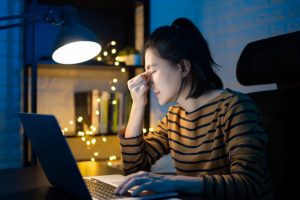
Dry eyes make your work day feel longer? Digital eye strain may be the culprit.
Digital eye strain is multifactorial, meaning that there are several different causes.
One cause of digital eye strain is the decreased number of times we blink when staring at a screen. The blink rate, which is usually about 16-18 times a minute, decreases by one half, or just eight blinks a minute when staring at a screen. Blinking spreads a thin layer of water and oils (called the tear film) over the surface of your eye. Your tear film helps protect your eyes from infections, injury, and irritation. Tiny glands lining your eyelids, called the meibomian glands, produce the lubricating oils that are an essential ingredient of nourishing tears. Without regular blinking, small dry areas develop which can result in a gritty feeling and blurred vision. You then strain to see your screen, your eyes work harder, and they get more tired.
Another cause of digital eye strain is reading on a screen. Screen reading is harder work for your eyes than reading a printed page. The location of the ink on the paper page does not change so it is easier for our eyes to focus. In contrast, words on a computer screen requires our eyes to work constantly to find exactly where the pixel may be and to bring it into focus. This creates digital eye strain.
Digital multi-tasking can also cause digital eye strain. Switching back and forth between social media scrolling on our phones and binge-watching a show on the television or tablet tires out our eyes. According to a national study, women are more likely than men to use multiple devices simultaneously and are more likely to report back and neck pain. Holding devices closer to your eyes to see better, as we do with phone screens, also decreases blink rate.
Adding a little self-care for your eyes to your daily hygiene routine is easy, and your eyes will thank you.
The 5 Tips for Reducing Digital Eye Strain
Taking small steps to help ourselves feel better can save us both time and money. Following these five tips, recommended by eye care professionals, can help minimize your symptoms of digital eye strain and keep your eyes healthy.
- Follow the 20-20-20 rule.
- Practice regular eye hygiene morning and night.
- Mask up daily with a heated eye mask like the Bruder Moist Heat Eye Compress.
- Make your workstation eye-friendly.
- Get regular, comprehensive eye exams.
1. Follow the 20-20-20 Rule.
2. Practice eye hygiene morning and night.
Regular eye hygiene, especially if you are a contact lens or eye makeup wearer, helps keep your eyes healthy. When our eyes are tired or uncomfortable, we rub them. Our dirty fingers easily transmit germs and irritants to your eyes. So, if you have digital eye strain, you are more than likely touching your eyes so that you may be at greater risk for a harmful eye infection.
Regularly using hygienic eye wipes, like the Bruder Hygenic Eyelid Cleansing Wipes, to remove makeup, dirt, and germs from your eyelids, a non-irritating eyelid cleansing spray like Bruder Hygienic Eyelid Solution (0.02% pure hypochlorous acid in saline), and the correct contact lens cleaning routine for your lenses can all keep your eyes healthy. Other examples of good eye-friendly practices are:
- Regularly changing your contact lenses
- Switching to your glasses if you are spending long hours in front of the computer
- Not wearing your contact lenses to bed

Blurry Vision? Dry Eye and Screen Time May Be to Blame
3. Use a Soothing Eye Mask Daily.
Tears evaporate more slowly and spread more evenly over dry areas when mixed with your body’s natural lubricating oils. You can boost your eyelid’s natural digital-eye-strain-protection system by self-treating these glands. You can do this without any medication or complicated treatments.
Research has shown that daily application of moist heat from a heated eye compress such as the Bruder dry eye mask helps these glands release more oil, slow tear evaporation, and stabilize your tear film. In addition, when your eyes are well-lubricated, they can better expel bacteria and debris. Not to mention that you are forcing your eyes to take a screen break when you mask up the Bruder’s heated eye mask, designed for maximum comfort. Daily screen-time masking breaks will leave you feeling more relaxed and your eyes feeling refreshed and rejuvenated.
4. Modify Your Workstation
There are several adjustments to make your work area more eye-friendly. Parts of your workstation to adjust to minimize digital eye strain are:
- Lighting. Both too much and too little light are bad for your eyes. Try to position your computer screen so that exterior windows are to the side, not in front of or behind your screen. Try turning off harsh overhead fluorescent lights and use floor lamps that provide indirect “soft white” LED lighting instead.
- Office Ergonomics. Check that your computer screen is 20 to 24 inches from your eyes. The center of your screen should be about 10 to 15 degrees below your eyes to avoid straining your neck or shoulders. If you sit at a desk or table, your feet should be able to rest comfortably on the floor with your thighs parallel to the floor.
- Display and screen settings. Choose a flat-panel LED (light-emitting diode) screen with an anti-reflective surface to avoid the fatal “flicker” that can exhaust your eyes. Check the resolution. Eyes prefer a dot pitch of 0.028 mm or smaller, and the larger your display screen, the better (a diagonal screen size of at least 19 inches) for desktop computers. Adjusting features on your computer screen can also improve long-term eye comfort. The features to play with are: brightness, text size and contrast, and color temperature. Of course, minimizing time spent working on smaller screens such as laptops, tablets, and screens will also help digital eye strain symptoms.
EYE CARE TIP
A Daily Eye Hygiene Routine Can Help:
- Your eyes feel more comfortable after screen use
- Relieve symptoms of dry eye
- Prevent future eye problems
5. Get Regular, Comprehensive Eye Exams.
Healthy vision starts with having regular eye exams because your vision changes over time. That is why the American Ophthamology Association recommends everyone have a baseline eye exam by age 40, or earlier if you are experiencing any eye symptoms or vision changes. August happens to be National Eye Exam month, so why not give your local eye doctor a call?
If you have certain health conditions such as diabetes or high blood pressure, or already have eye glasses or lenses, you should have a comprehensive eye exam once a year. Those people who are nearsighted, have astigmatism, or other eye conditions are at greater risk for digital eye strain.

